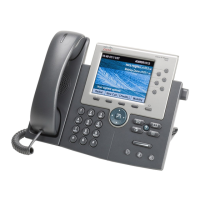1-6
Cisco Unified IP Phone 7965G and 7945G Administration Guide for Cisco Unified Communications Manager 6.0
OL-12650-01
Chapter 1 An Overview of the Cisco Unified IP Phone
What Networking Protocols Are Used?
Cisco Peer to Peer
Distribution Protocol
(CPPDP)
CPPDP is a Cisco proprietary
protocol used to form a peer to peer
hierarchy of devices. CPPDP is also
used to copy firmware or other files
from peer devices to neighboring
devices.
CPPDP is used by the Peer Firmware
Sharing feature.
Real-Time Control
Protocol (RTCP)
RTCP works with Real-Time
Transport Protocol (RTP) to provide
QoS data (such as jitter, latency, and
round trip delay) on RTP streams.
RTCP is disabled by default, but you
can enable it on a per phone basis
using Cisco
Unified
Communications Manager.
For more information, see the
“Network Configuration” section on
page 4-29.
Real-Time Transport
Protocol (RTP)
RTP is a standard protocol for
transporting real-time data, such as
interactive voice and video, over data
networks.
Cisco Unified IP Phones use the RTP
protocol to send and receive
real-time voice traffic from other
phones and gateways.
Session Initiation
Protocol (SIP)
SIP is the Internet Engineering Task
Force (IETF) standard for
multimedia conferencing over IP. SIP
is an ASCII-based application-layer
control protocol (defined in
RFC
3261) that can be used to
establish, maintain, and terminate
calls between two or more endpoints.
Like other VoIP protocols, SIP is
designed to address the functions of
signaling and session management
within a packet telephony network.
Signaling allows call information to
be carried across network
boundaries. Session management
provides the ability to control the
attributes of an end-to-end call.
Skinny Client Control
Protocol (SCCP)
SCCP includes a messaging set that
allows communications between call
control servers and endpoint clients
such as IP Phones. SCCP is
proprietary to Cisco Systems.
Cisco Unified IP Phones use SCCP
for call control. You can configure
the Cisco Unified
IP Phone to use
either SCCP or Session Initiation
Protocol (SIP).
Session Description
Protocol (SDP)
SDP is the portion of the SIP protocol
that determines which parameters are
available during a connection
between two endpoints. Conferences
are established using only the SDP
capabilities that are supported by all
endpoints in the conference.
SDP capabilities, such as codec
types, DTMF detection, and comfort
noise, are normally configured on a
global basis by Cisco Unified
Communications Manager or Media
Gateway in operation. Some SIP
endpoints may allow these
parameters to be configured on the
endpoint itself.
Transmission Control
Protocol (TCP)
TCP is a connection-oriented
transport protocol.
Cisco Unified IP Phones use TCP to
connect to Cisco
Unified
Communications Manager
and to access XML services.
Table 1-1 Supported Networking Protocols on the Cisco Unified IP Phone (continued)
Networking Protocol Purpose Usage Notes

